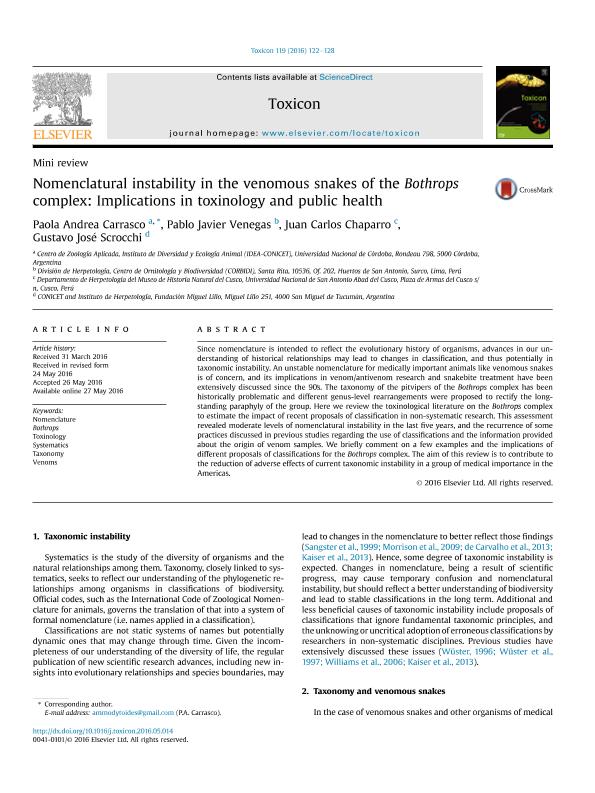Mostrar el registro sencillo del ítem
dc.contributor.author
Carrasco, Paola Andrea

dc.contributor.author
Venegas, Pablo Javier
dc.contributor.author
Chaparro, Juan Carlos
dc.contributor.author
Scrocchi Manfrini, Gustavo Jose

dc.date.available
2018-08-17T16:43:13Z
dc.date.issued
2016-09
dc.identifier.citation
Carrasco, Paola Andrea; Venegas, Pablo Javier; Chaparro, Juan Carlos; Scrocchi Manfrini, Gustavo Jose; Nomenclatural instability in the venomous snakes of the Bothrops complex: Implications in toxinology and public health; Pergamon-Elsevier Science Ltd; Toxicon; 119; 9-2016; 122-128
dc.identifier.issn
0041-0101
dc.identifier.uri
http://hdl.handle.net/11336/56166
dc.description.abstract
Since nomenclature is intended to reflect the evolutionary history of organisms, advances in our understanding of historical relationships may lead to changes in classification, and thus potentially in taxonomic instability. An unstable nomenclature for medically important animals like venomous snakes is of concern, and its implications in venom/antivenom research and snakebite treatment have been extensively discussed since the 90s. The taxonomy of the pitvipers of the Bothrops complex has been historically problematic and different genus-level rearrangements were proposed to rectify the long-standing paraphyly of the group. Here we review the toxinological literature on the Bothrops complex to estimate the impact of recent proposals of classification in non-systematic research. This assessment revealed moderate levels of nomenclatural instability in the last five years, and the recurrence of some practices discussed in previous studies regarding the use of classifications and the information provided about the origin of venom samples. We briefly comment on a few examples and the implications of different proposals of classifications for the Bothrops complex. The aim of this review is to contribute to the reduction of adverse effects of current taxonomic instability in a group of medical importance in the Americas.
dc.format
application/pdf
dc.language.iso
eng
dc.publisher
Pergamon-Elsevier Science Ltd

dc.rights
info:eu-repo/semantics/openAccess
dc.rights.uri
https://creativecommons.org/licenses/by-nc-sa/2.5/ar/
dc.subject
Bothrops
dc.subject
Nomenclature
dc.subject
Systematics
dc.subject
Taxonomy
dc.subject
Toxinology
dc.subject
Venoms
dc.subject.classification
Otras Ciencias Biológicas

dc.subject.classification
Ciencias Biológicas

dc.subject.classification
CIENCIAS NATURALES Y EXACTAS

dc.title
Nomenclatural instability in the venomous snakes of the Bothrops complex: Implications in toxinology and public health
dc.type
info:eu-repo/semantics/article
dc.type
info:ar-repo/semantics/artículo
dc.type
info:eu-repo/semantics/publishedVersion
dc.date.updated
2018-08-17T14:29:55Z
dc.journal.volume
119
dc.journal.pagination
122-128
dc.journal.pais
Países Bajos

dc.journal.ciudad
Amsterdam
dc.description.fil
Fil: Carrasco, Paola Andrea. Consejo Nacional de Investigaciones Científicas y Técnicas; Argentina. Universidad Nacional de Córdoba. Facultad de Ciencias Exactas Físicas y Naturales. Centro de Zoología Aplicada; Argentina
dc.description.fil
Fil: Venegas, Pablo Javier. Centro de Ornitología y Biodiversidad; Perú
dc.description.fil
Fil: Chaparro, Juan Carlos. Universidad Nacional de San Antonio Abad del Cusco; Perú
dc.description.fil
Fil: Scrocchi Manfrini, Gustavo Jose. Consejo Nacional de Investigaciones Científicas y Técnicas; Argentina. Fundación Miguel Lillo. Dirección de Zoología. Instituto de Herpetología; Argentina
dc.journal.title
Toxicon

dc.relation.alternativeid
info:eu-repo/semantics/altIdentifier/doi/https://dx.doi.org/10.1016/j.toxicon.2016.05.014
dc.relation.alternativeid
info:eu-repo/semantics/altIdentifier/url/https://www.sciencedirect.com/science/article/pii/S004101011630143X
Archivos asociados
